Wat Rong Khun, better known as the 'White Temple' is one of the most recognisable temples in Thailand. Located 13km outside of Chiang Rai city, it is often the primary reason for tourists to come to the area and attracts a large number of visitors, both Thai and foreign.
But do you really know all the symbolism and the reason for this jewel of Thai architecture and know-how?
The origins of Wat Rong Khun
Wat Rong Khun, better known as the White Temple, is a unique work of art created by Thai artist Chalermchai Kositpipat, a native of Chiang Rai. Already at the height of his career in the mid-1990s, Chalermchai wanted to both pay tribute to King Bhumibol (Rama IX) and offer an exceptional attraction to his hometown. The project began in 1996, on the ruins of an ancient temple, combining his personal ambition with an artistic and spiritual quest.
More than just a place of worship, the White Temple is a work of art in its own right, where traditional Thai architecture blends with bold contemporary elements. Every detail, from the sculptures to the frescoes, illustrates Buddhist principles such as karma and enlightenment, while incorporating surprising references to popular culture and the issues of our time.
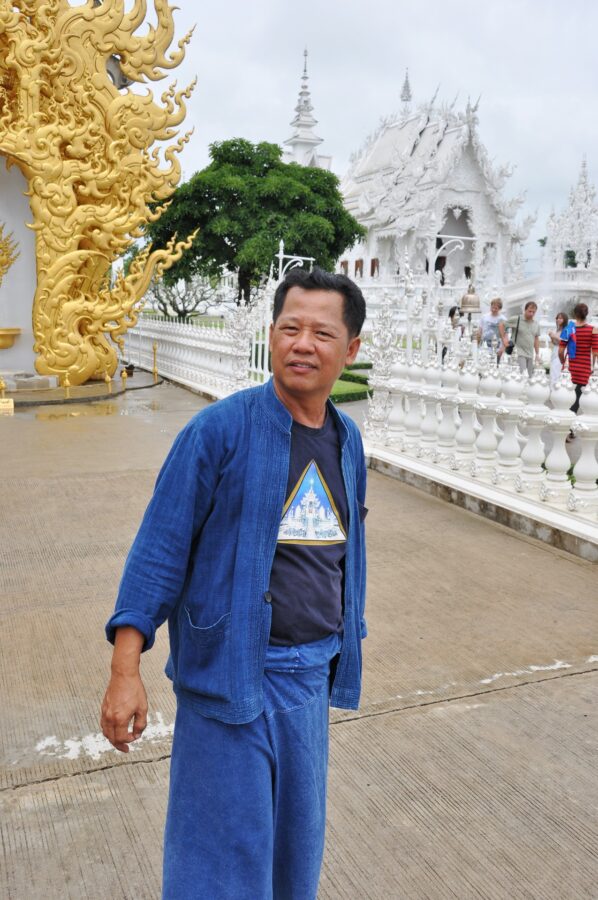
A monumental ambition
Through Wat Rong Khun, Chalermchai helped put Chiang Rai on the international stage, in a region that was still struggling to recover from the conflicts surrounding the opium trade in the Golden Triangle. Today, the temple is one of Thailand's most iconic and visited sites.
This monumental project represents a colossal challenge, both artistically and financially. Chalermchai has already invested more than 40 million Baht (more than a million euros) of his personal fortune, while refusing large funding, particularly from the state, to preserve his creative independence. He estimates that the complex will not be completed until 2070, making Wat Rong Khun a work in perpetual evolution.
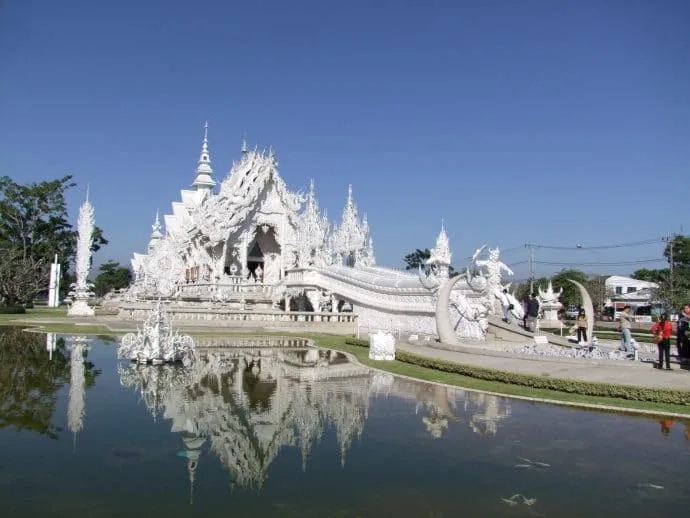
Challenges and Legacy
In 2014, a major earthquake nearly compromised this masterpiece, causing significant damage. This event caused great emotion in Thailand, as the temple has become a national symbol. Fortunately, after two years of work, the structure was consolidated, and the temple was able to fully reopen, thus continuing its role as an artistic and spiritual jewel.
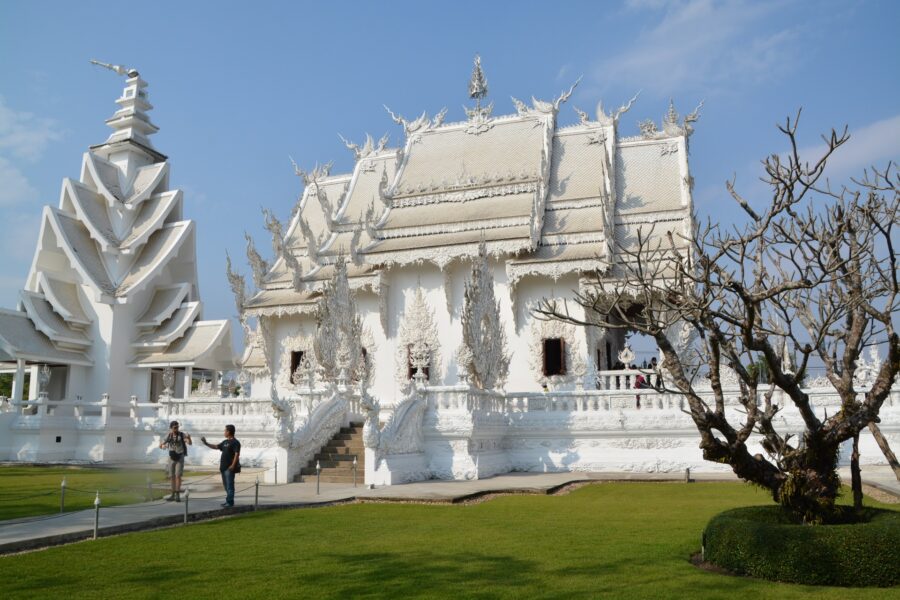
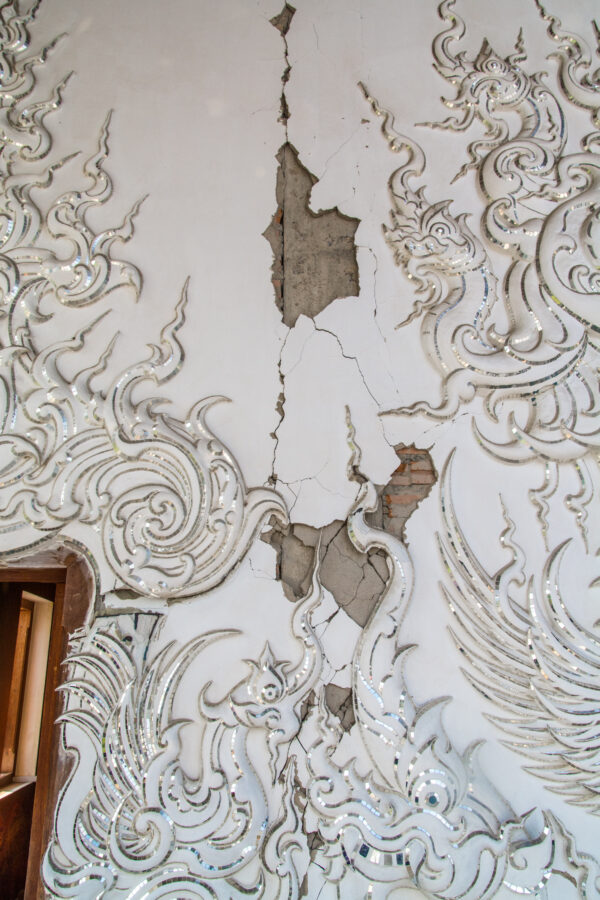
For a long time free, the site is now accessible for 100 Baht. This decision, taken by the management committee, aims to improve the infrastructure to accommodate the many visitors and ensure the maintenance of the complex after the death of its creator. Despite this change, the artist remains faithful to his initial project: to make Wat Rong Khun a place of Buddhist learning and meditation, well beyond its function as a simple tourist attraction.
Architecture and symbolism of the white temple
In order to understand a little about what surrounds you, I will discuss here the symbolism behind the statues and figures that many will find just "amusing", but without grasping the hidden message behind them.
First of all, it is important to understand that the temple's distinctive whiteness, for which it is famous, symbolizes the purity of Buddhism. It is this same purity that is represented by the white in the Thai flag (with blue for royalty, and red for the people).
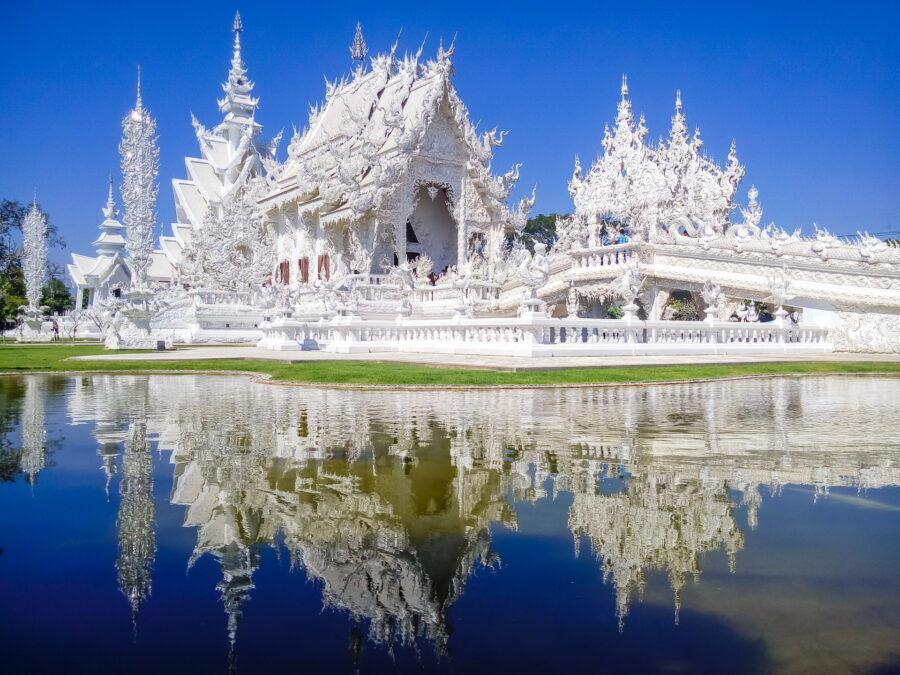
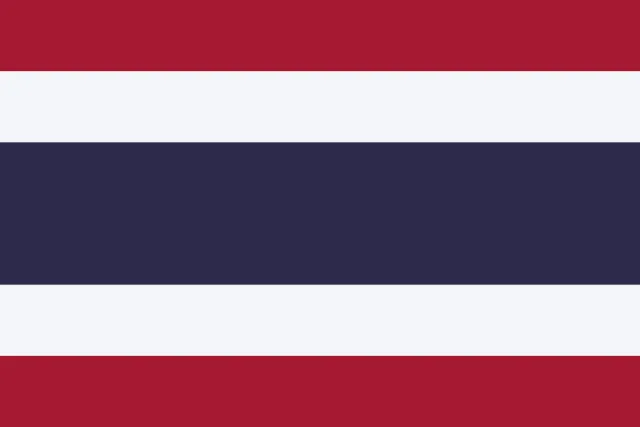
Chalermchai Kositpipat, its creator, wanted to design this place as an earthly incarnation of paradise, a spiritual refuge inviting humans to rise above material concerns.
Behind the fascinating and sometimes disconcerting sculptures, there is actually a deep reflection by the artist, mixing tradition and modernity. However, the temple is not limited to classical Buddhist symbols; and in order to reach a wide audience, it deliberately integrates surprising references to contemporary popular culture.
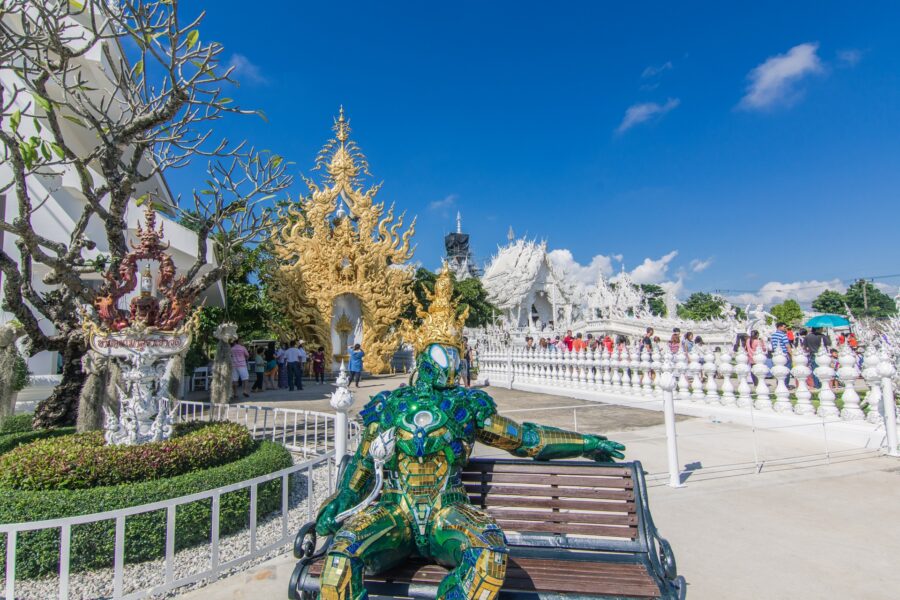
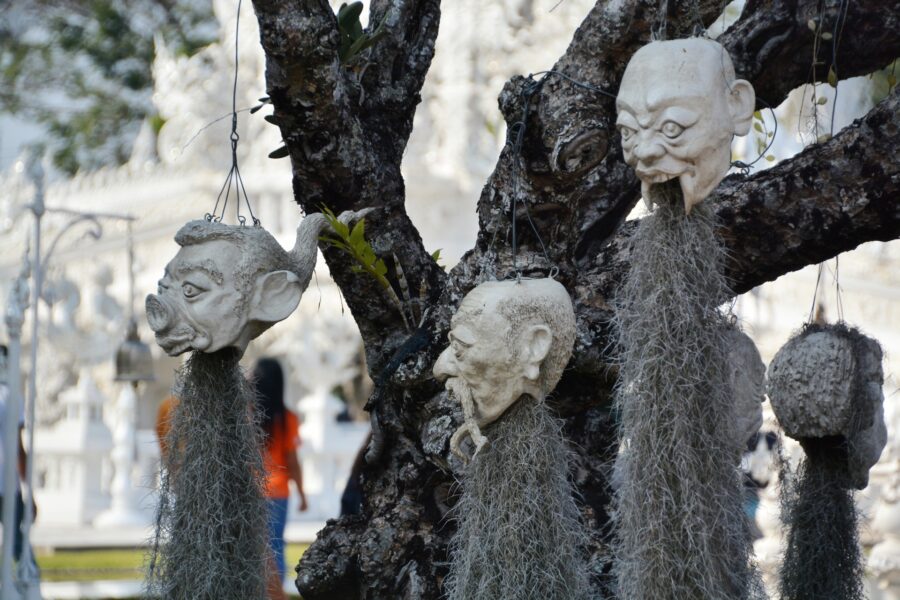
This is why you will see, for example, pots hanging in trees bearing the faces of iconic Hollywood movie characters – heroes and villains alike.
Inside the main chapel, where photos are prohibited, visitors discover a stunning fresco mixing historical, heroic and catastrophic figures. Superman, Neo de Matrix, or even Alien, rub shoulders with representations such as the twin towers of the World Trade Center on fire.
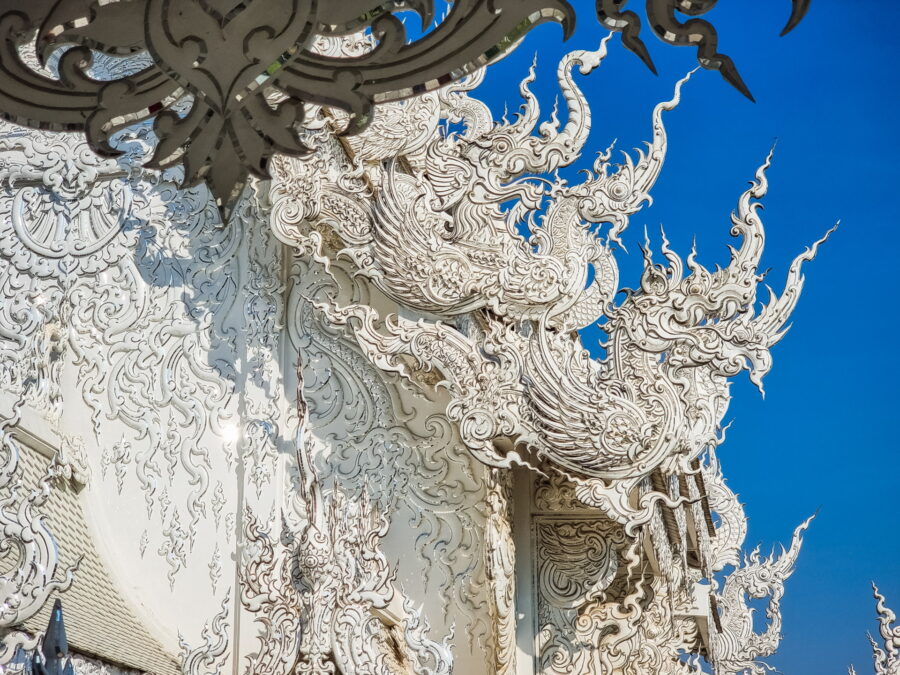
Every detail illustrates humanity's struggles against the destructive forces of ego, desire and greed. The artist continues to add characters as the films are released, constantly evolving his work.
The temple, in its entirety, is conceived as a spiritual journey. The sculptures, frescoes and walkways symbolize the quest to escape worldly temptations and focus on what is essential: the mind. Chalermchai thus invites each visitor to reflect on Buddhist teachings and find their own path to enlightenment.
Finally, last little bit of information, you will notice that the temple and the structures decorating it are covered with small pieces of glass similar to mirrors. They represent the wisdom and teachings of the Buddha, radiating throughout the universe.
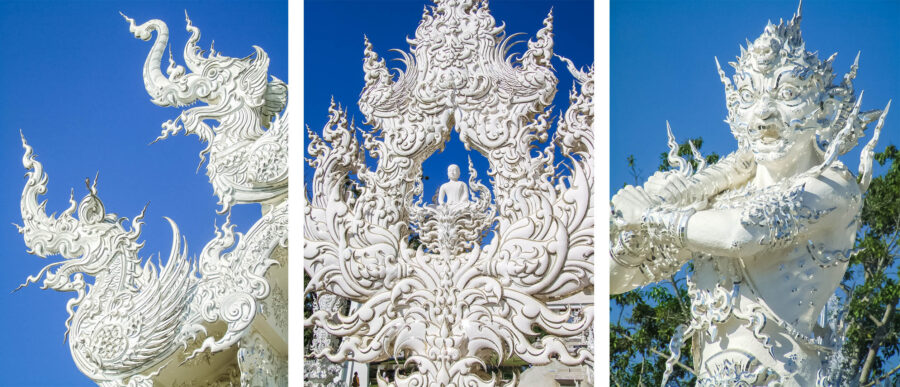
The bridge of the “cycle of rebirth”
To reach the Ubosot, the main building of the White Temple, one must cross a unique passage, loaded with symbolism. Around this bridge, skulls and hundreds of hands stretched out towards the sky seem to emerge from the depths, evoking insatiable desire and human suffering, symbols of hell and earthly torments.
This "bridge of the cycle of rebirth" represents the passage out of the cycle of death and reincarnation. It invites us to overcome temptations and greed to achieve an existence free from suffering, thus beginning a spiritual path towards purity and awakening.

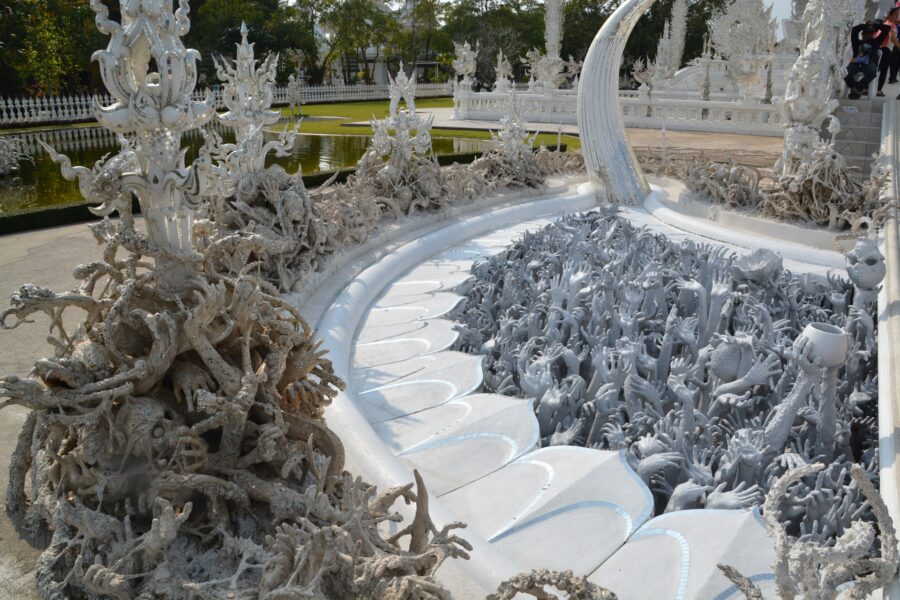
The "Gate of Heaven"
After crossing the bridge symbolizing the crossing of earthly sufferings, the visitor finds himself facing what is called the "gate of paradise". It is guarded by two imposing mythological creatures: Death and Rahu. These two powerful figures embody the judgment and destiny of Men, deciding their fate after death according to their past actions.
Before entering the main building, you walk along a bridge surrounded by classical Naga figures on each side. Looking around, you will notice several representations of Buddha in meditation positions, symbolizing serenity and the attainment of enlightenment, a subtle reminder of the ultimate goal of Buddhist spirituality.
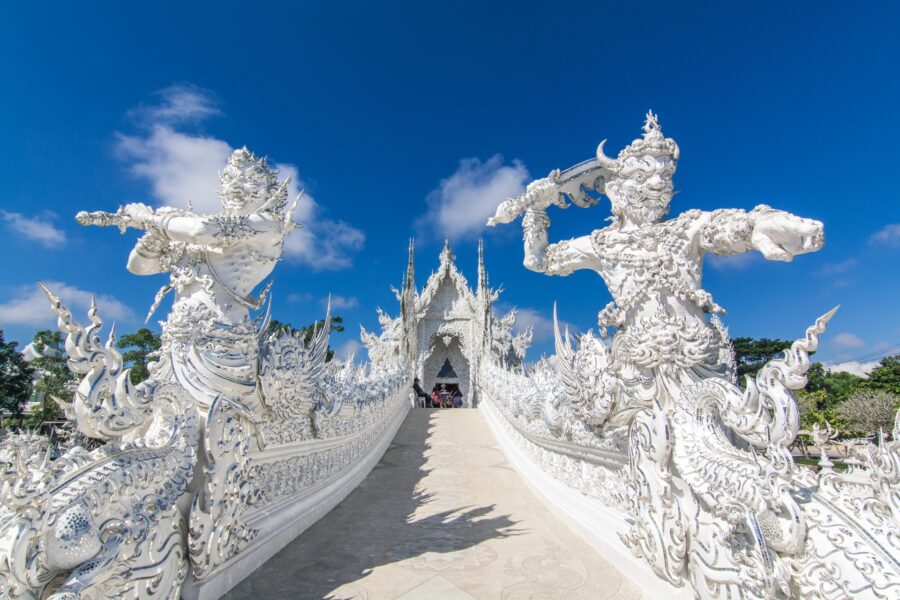
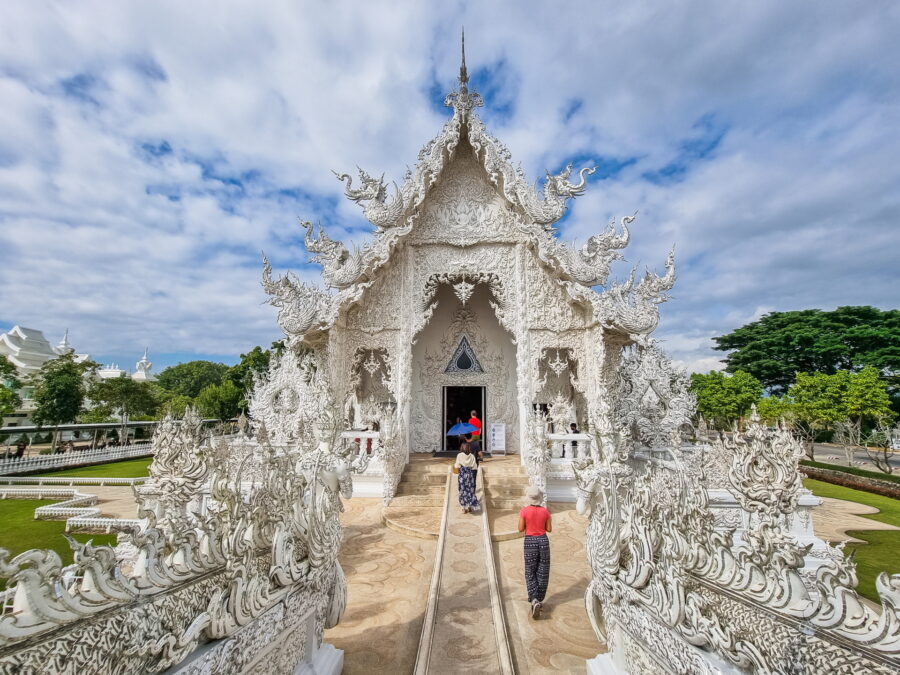
The Ubosot
The most important building at Wat Rong Khun, the Ubosot or ordination hall, is an all-white building with fragments of reflective glass in the plaster. The Ubosot takes design elements from classical northern Thai temples, such as the three-tiered roof.
While usually the murals inside depict scenes from life related to the story of Buddha, here we find colorful patterns, and characters like those mentioned above, which are a modern representation of good and evil.
At the back, in the usual location, you will have a statue of Buddha in a sitting position. The variation is that you will also see a wax statue of a monk in a meditation position, amazingly realistic.
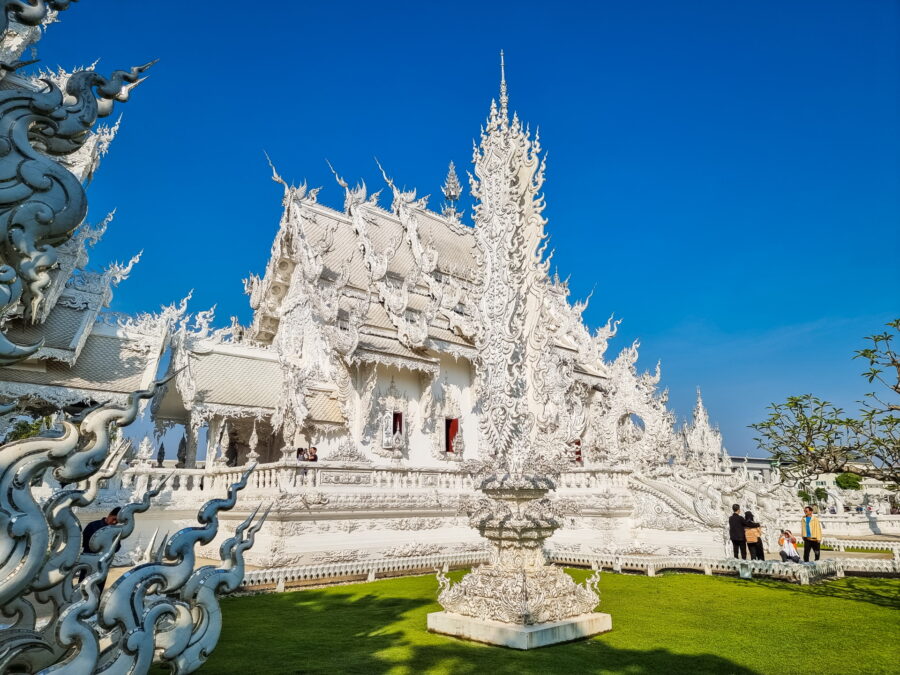
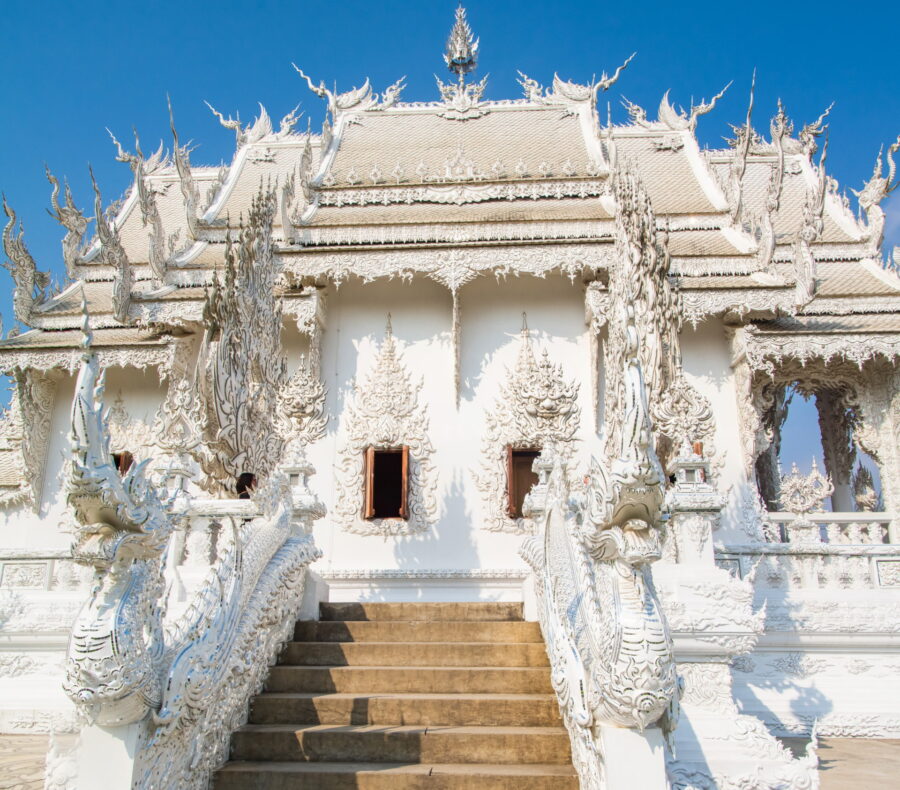
Other structures of the White Temple
Of course, the White Temple is not limited to the Ubosot. While exploring the site, several other buildings and features are worth paying attention to. Before talking about specific places, it is difficult not to mention the gardens that surround the main building. With its ponds, small bridges and structures still being decorated, the site exudes a very photogenic atmosphere.
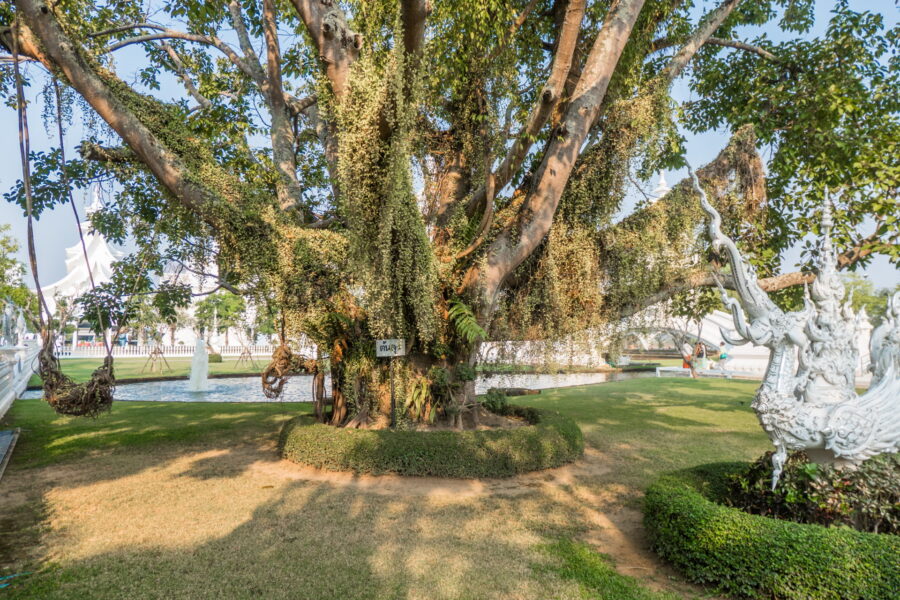
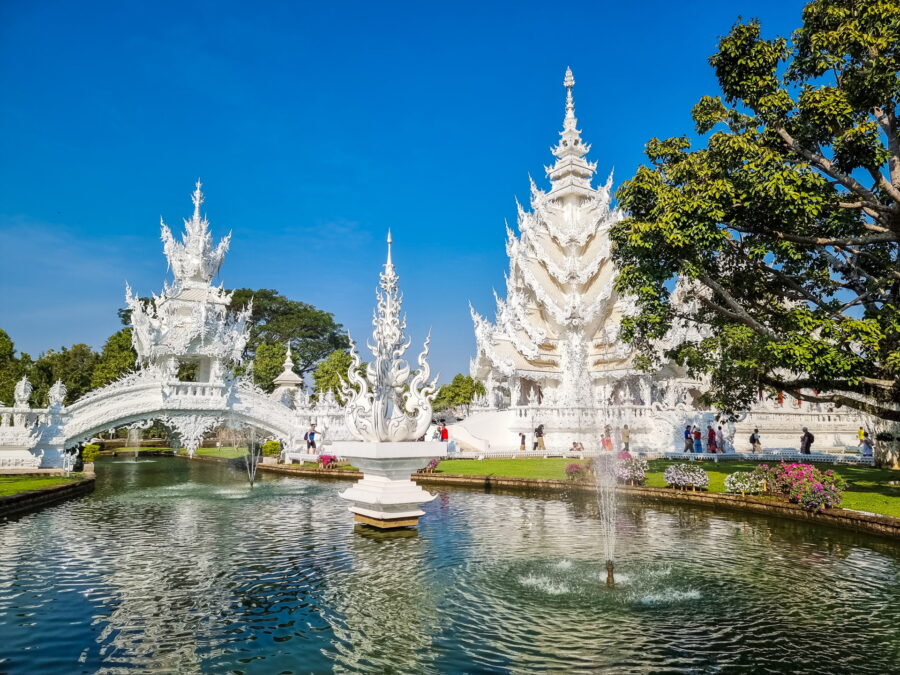
Artist Chalermchai Kositpipat continues to perfect his work (although he now only supervises from afar, as he is officially retired) and each visit can reveal new sculptures or unexpected additions. If you are lucky enough to return after a few years, you will be able to see for yourself how the place has evolved.
A concrete example? Compare the following two photos: although the angle is different, the bridge you see is indeed the same, but the details have been enriched over time.
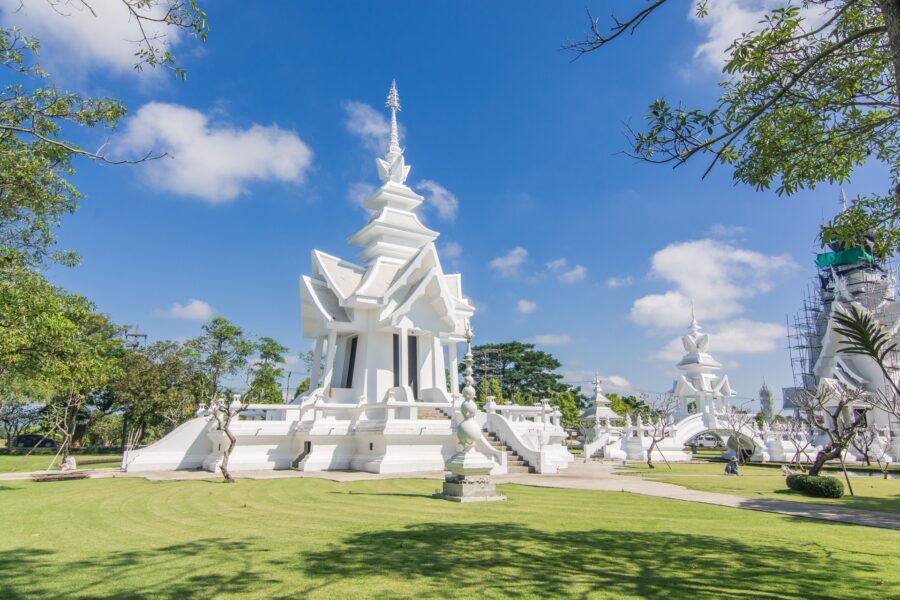
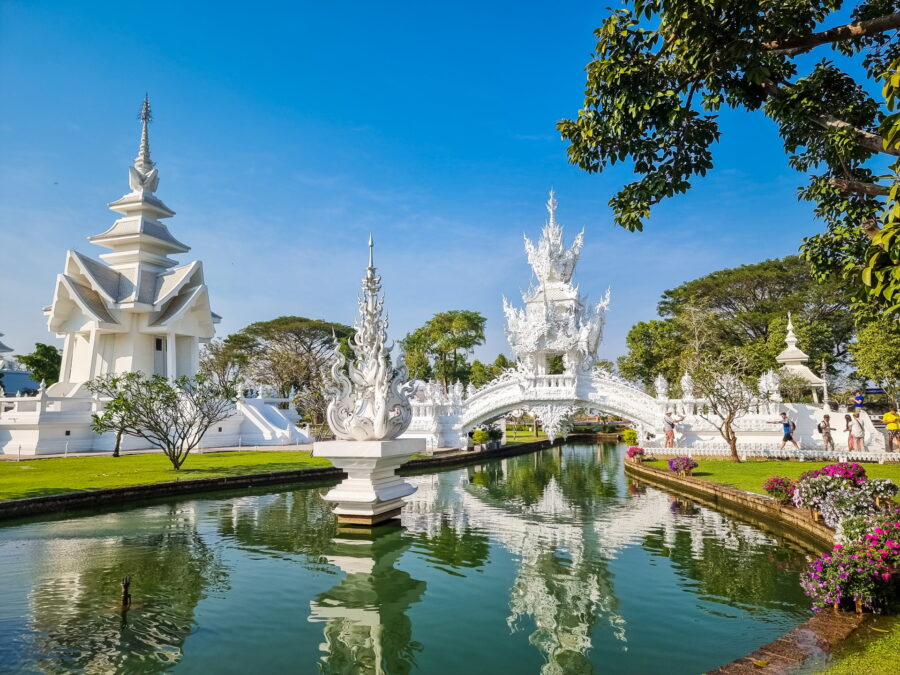
The Golden Building
Right next to the Ubosot, it’s hard not to notice a resplendent building, all dressed in yellow. And while that’s not all it is, it probably houses the most elegant toilets in Thailand! Yes, you read that right, it’s primarily a building dedicated to that purpose.
But here again, everything has a meaning. If the white Ubosot symbolizes the spirit, this golden building represents the body. According to his interpretation, its golden color embodies the human obsession with futile desires and the quest for wealth. In contrast, this structure also invites us to refocus on the spirit, rather than on material possessions.
Something to think about for a few moments during your… philosophical break.
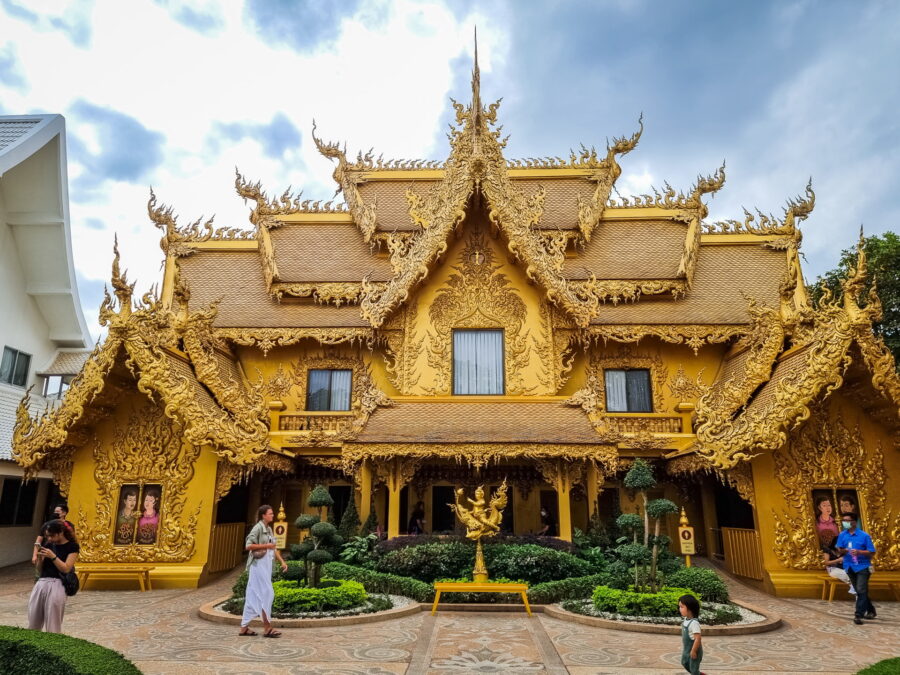

The wishing well and the donation trees
As you walk around the site, you will inevitably come across a crowd of visitors leaning around a covered promontory: this is where the wishing well, an attraction that intrigues young and old alike. The principle? Make a wish by tossing a coin and hope that it lands precisely in the center of the well, where a lotus-shaped structure lies underwater. A more delicate task than it seems!
But it is not just a game: while the act of throwing a coin into a fountain or a well to attract good fortune is common in many cultures, Chalermchai Kositpipat, faithful to his symbolic approach, uses the latter to subtly denounce human greed.
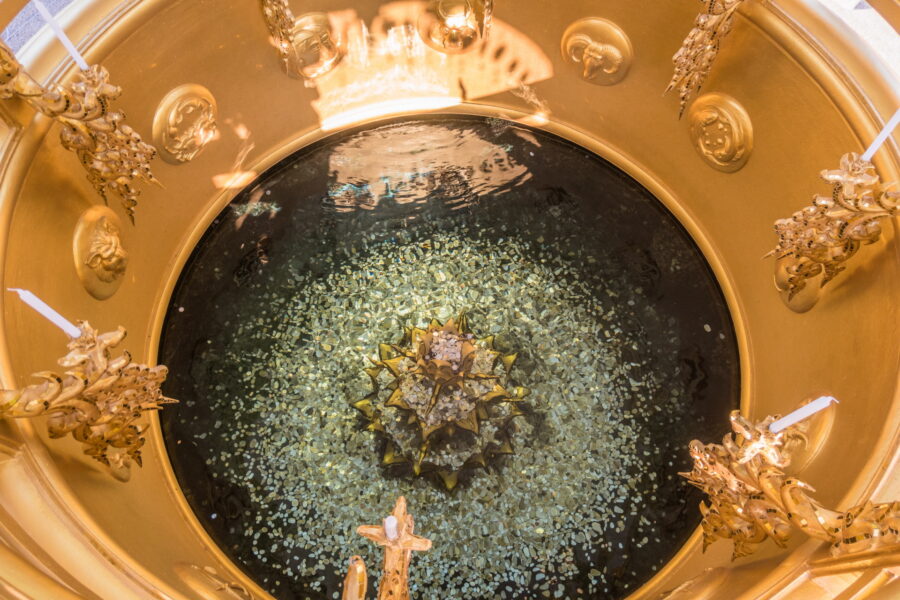
Around the well you will also notice “trees” decorated with golden leaves, hanging here and there, including from the ceiling of the covered walkway that runs along the garden surrounding the Ubosot. If you look closely, you will see that each leaf bears a name, a date or sometimes a wish left by a donor. A nearby kiosk will allow you, too, to participate in the preservation and development of the temple, beyond the entrance ticket.
When we know that each hanging golden leaf represents a donation of 30 Baht, and that they accumulate by the thousands (despite regular withdrawals to make room), we quickly realize the importance of this collective participation!
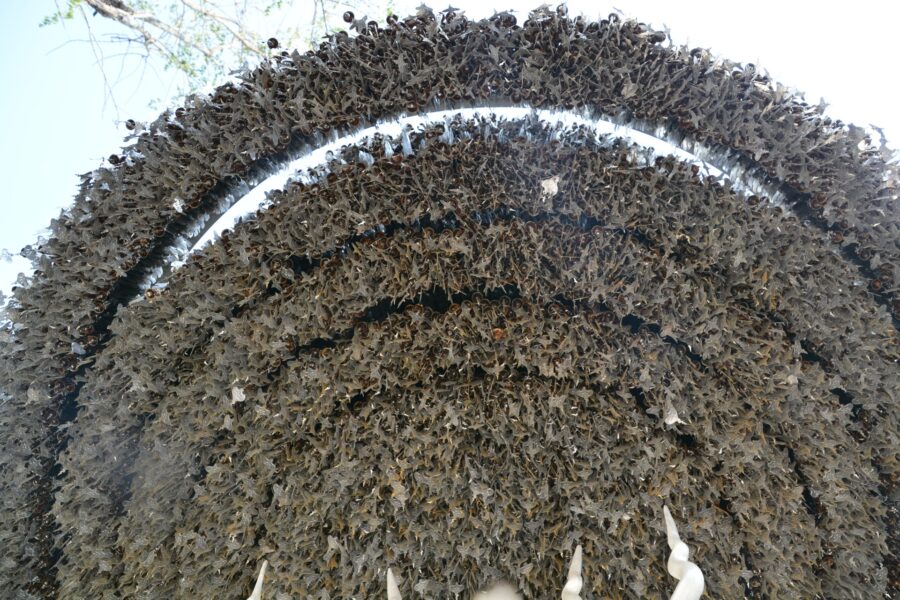
Cave of Art
La Cave of Art is one of the recent additions to the Wat Rong Khun complex. As you move towards the back of the site, you will notice a wall similar to a natural rock, surrounded by lush vegetation, over which small waterfalls flow. This intriguing setting houses an artificial cave that can be visited.
From what I've read, the inside of the cave offers an immersive experience that begins with a representation of hell, before guiding visitors to a more "heavenly" part, surrounded by Buddha statues and accompanied by soothing light shows. However, I've never visited this space, and for good reason: access to the Cave of Art requires a 50 baht supplement, not included in the Wat Rong Khun entrance ticket. Personally, I'm a little reluctant to pay for an attraction within an already paid attraction.
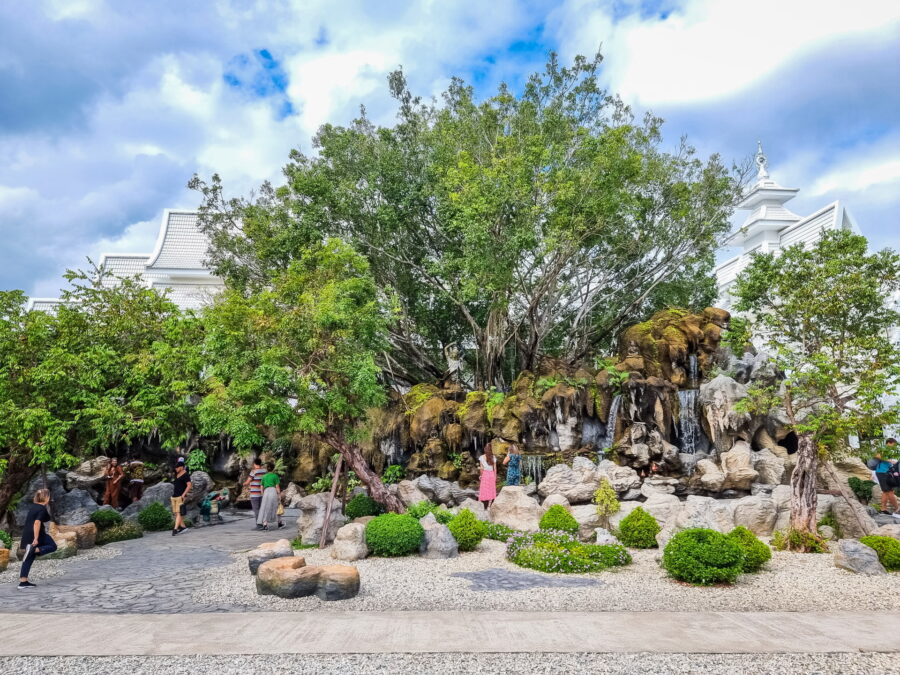
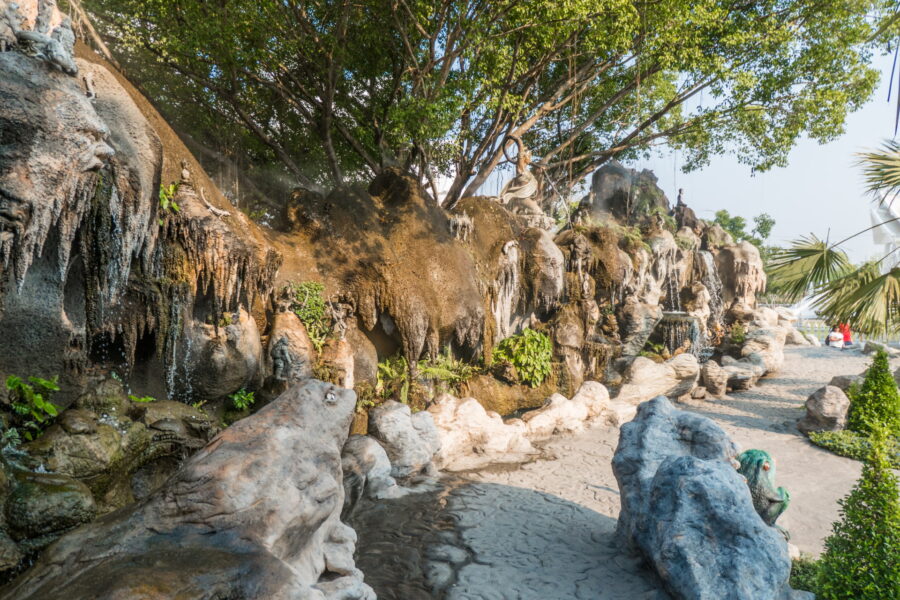
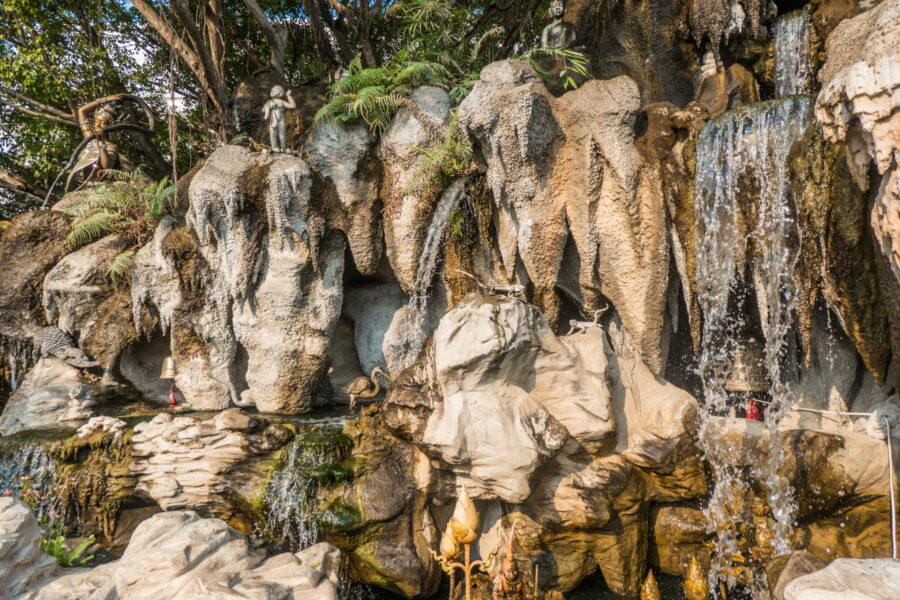

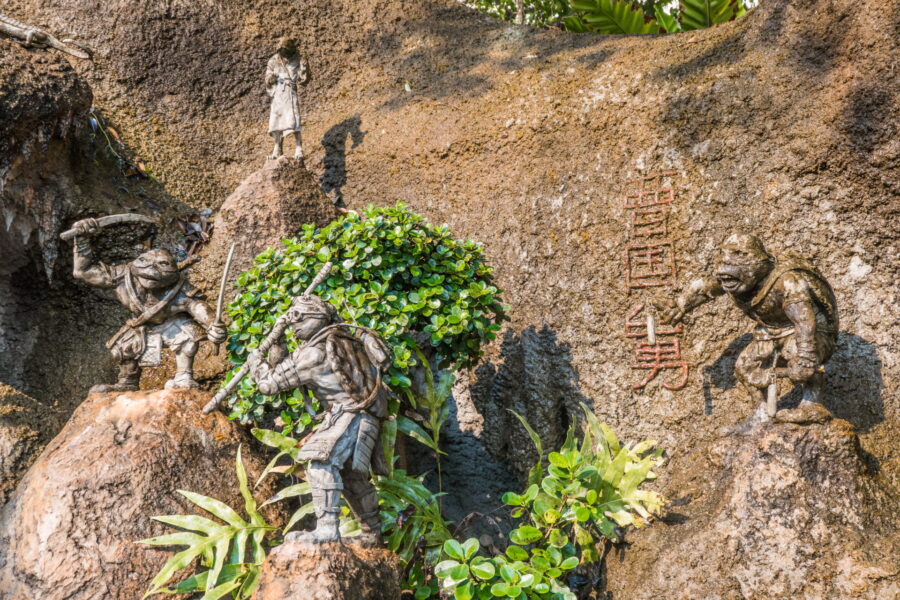
That said, feel free to take a look. You can see it as an additional donation to the art project. But even without entering, the exterior of this area is enough in itself: the external walls are decorated with surprising characters, mixing figures from Thai culture with pop culture icons, such as the Ninja Turtles or Venom.
Just before the Cave of Art, you will have a hanging bell above a small pond, surrounded by an elegant golden structure. Nearby, a shaded area set up under a banyan (tree with multiple drooping roots) invites you to take a break. A statue of Buddha in a meditation position is installed there, offering a moment of serenity in this soothing setting.
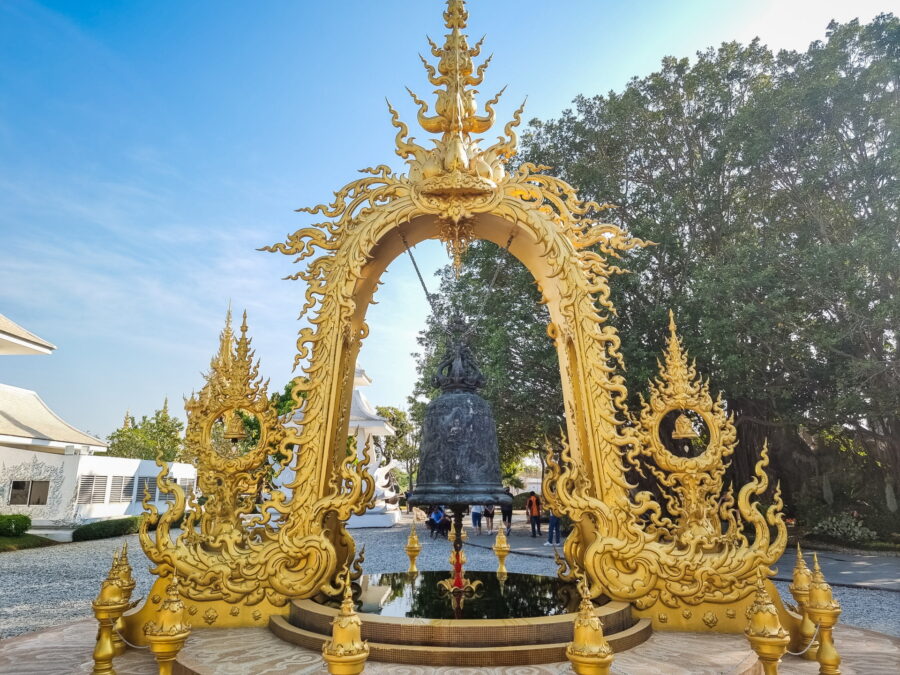
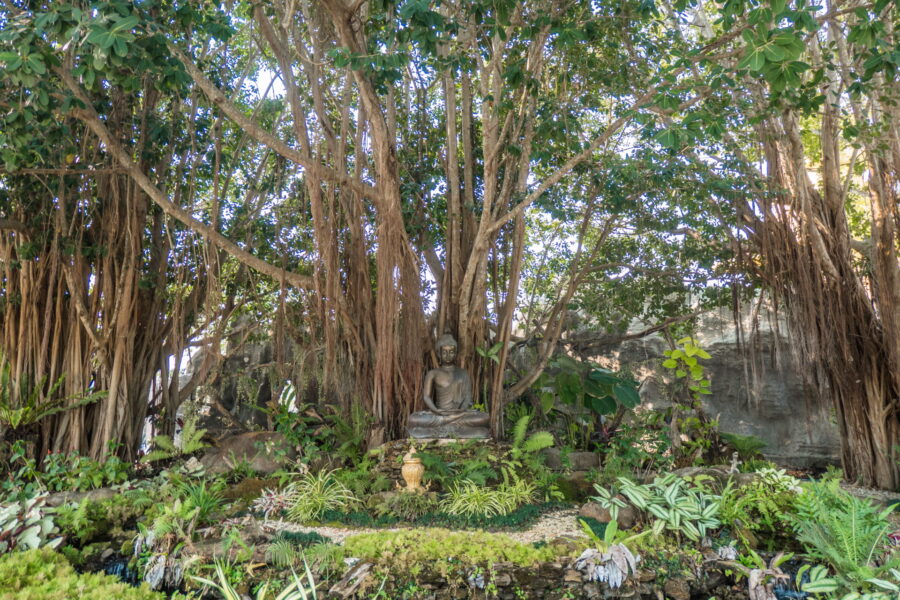
Golden Ganesha temple
Around the temple
Wat Rong Khun is such an attraction today that an entire economy has formed around the temple. You will therefore find somewhere to eat, sit in a café or do a little shopping in one of the souvenir shops opposite the white temple.
But there is at least one place you should take a look before you leave.
Chalermchai Kositpipat Museum
In the immediate vicinity of Wat Rong Khun, you can also visit the museum dedicated to the artist, called the Chalermchai Kositpipat Hall of MasterworkThis gallery allows you to delve into the artist's creative universe and discover the evolution of his unique style.
It features a large collection of his works, from his first paintings made at the age of 14 to more recent creations. This tour traces the emergence of his very particular style, mixing religious symbolism and representations of power. In parallel, you can admire some of his sculptures, amulets, and paintings in more classical styles, including a captivating series illustrating destinations he visited and interpreted in painting.
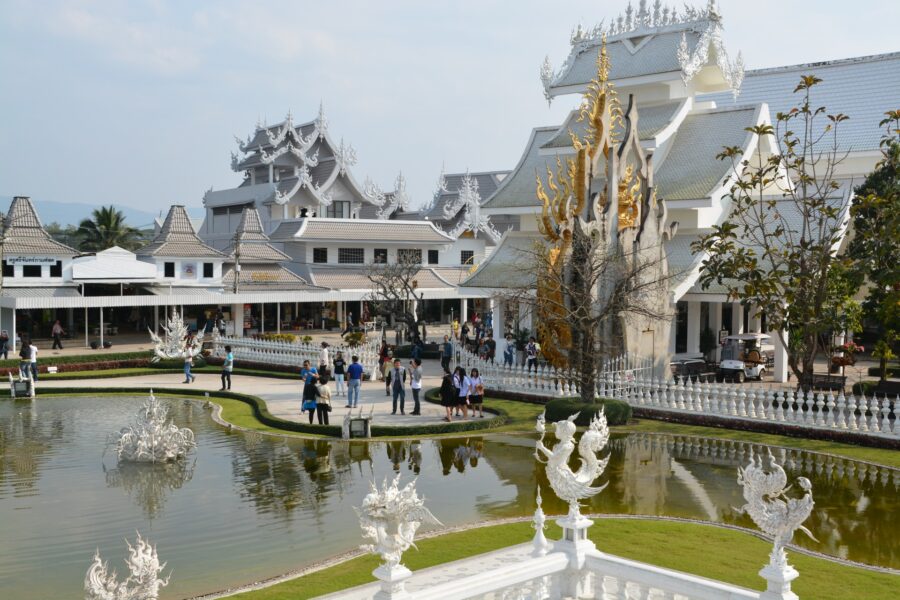
The gallery also has some surprises in store, with unexpected and sometimes surprising works at the end of the tour. It doesn't cost anything to take a look, especially since admission is free. Some of the paintings are really worth the detour, and it's a great way to enrich your visit to the White Temple while deepening your understanding of Chalermchai's vision.
One last surprise…
Wat Rong Khun is a temple that never lets itself be completely discovered, even after several visits. As proof, one day, I noticed a strange activity near the entrance: open trapdoors and busy workers. Intrigued, I thought at the time that it was maintenance work, perhaps for the water in the basins.
But in reality, it was about oyster farming ! Is it to collect pearls and mother-of-pearl? Probably, but who knows! This temple, definitely, always has its share of surprises.
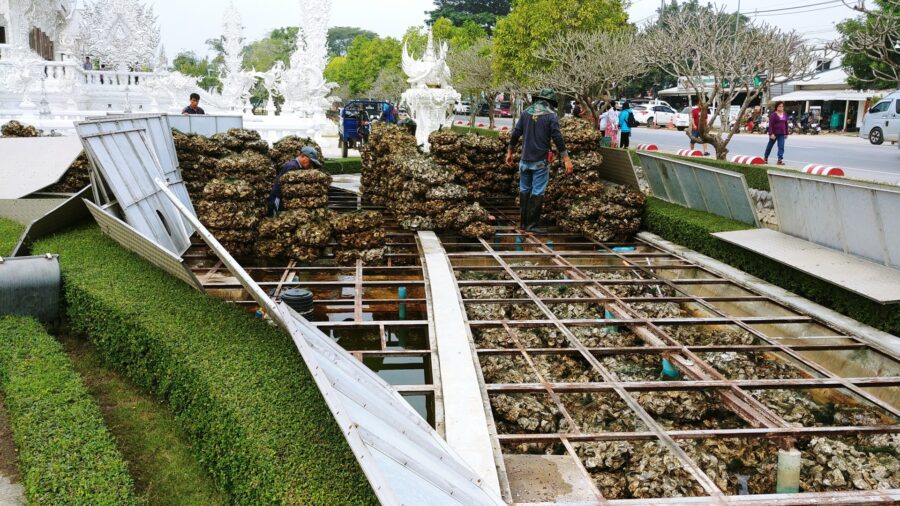
When to go to the White Temple?
If we talk purely about weather, northern Thailand is suitable for visits almost all year round, with the exception of the peak periods. February/March et September/October.
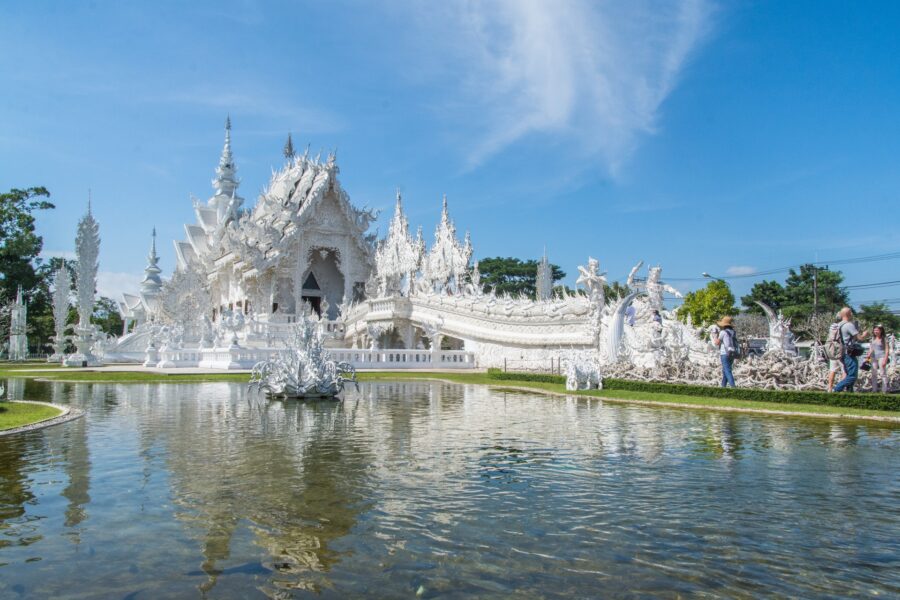
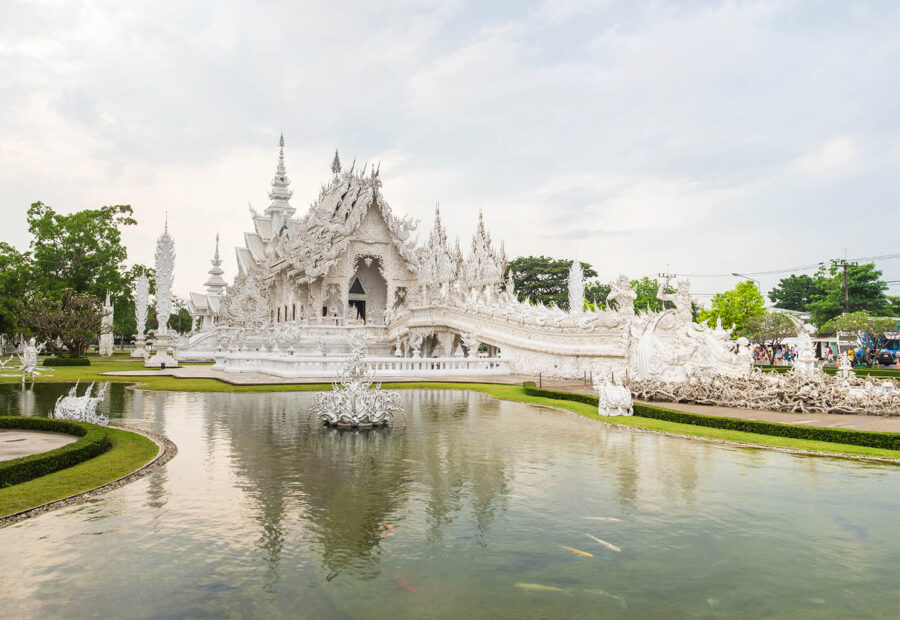
For me, the ideal month remains November, where you can admire the deep blue skies, as in some of the photos in this article. It is also the time of rice harvest which gives beautiful colors.
- February to April : This period combines intense heat, peak drought (making nature dull), and agricultural burning which causes significant air pollution, especially in February and March.
- May to August : With the month of May, the rainy season starts again, but it is rarely a hindrance to visits. The showers generally arrive in the late afternoon or evening, and nature becomes lush again. The rice fields, for their part, are replanted from July.
- September/October : Be careful, this is the peak of the monsoon season. The sky is often gray, and completely rainy days are more frequent.
Best times to avoid the crowds
- Early morning (at opening) : Ideal for arriving before the day tour groups from Chiang Rai.
- Late afternoon (after 16 p.m.) : A great option to avoid the crowds and enjoy a quieter atmosphere and benefit from a beautiful soft light at sunset, perfect for photos.
Overall, late morning and afternoon can be the busiest times, due to organized excursions from Chiang Rai and also from Chiang Mai.
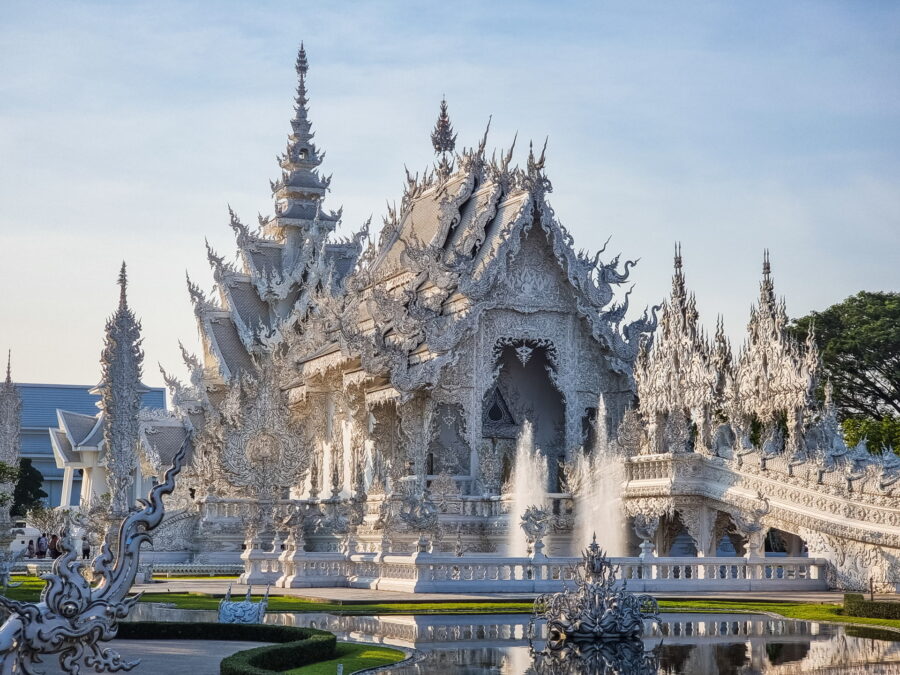
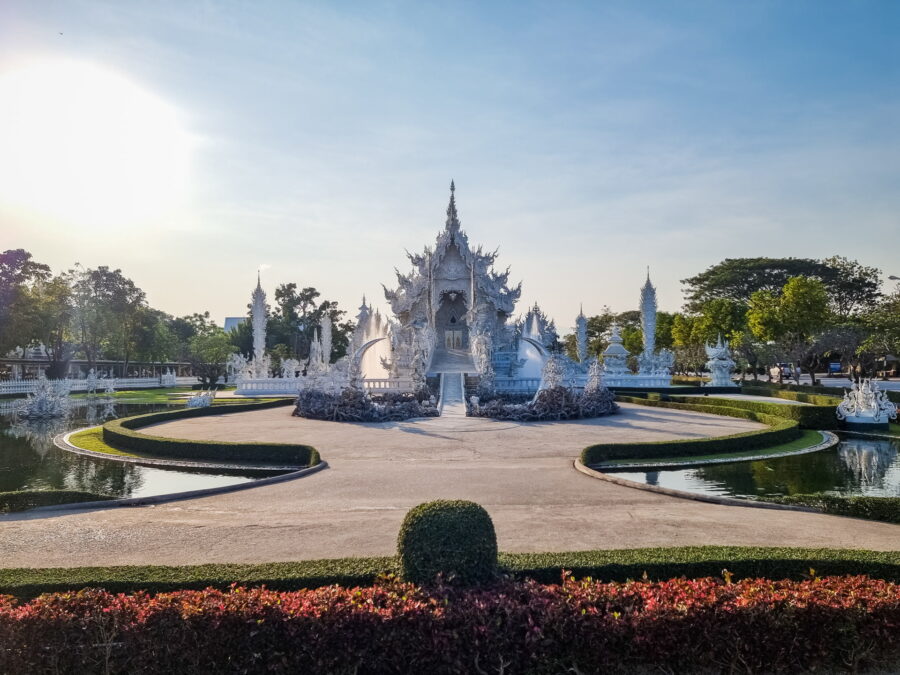
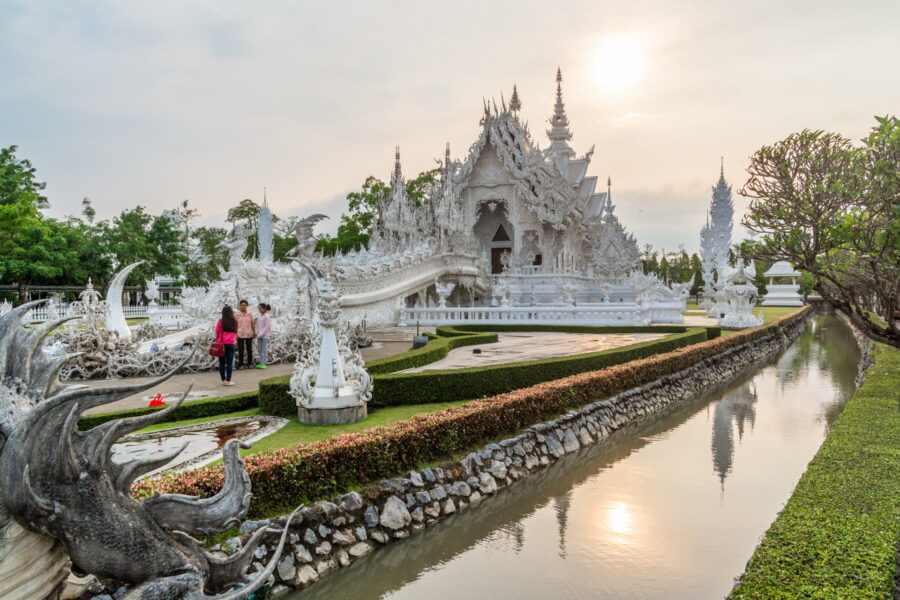
How to get to the white temple
Wat Rong Khun is located along National Road No. 1 (Phahonyothin Road), approximately 13 kilometers southwest of Chiang Rai. Regardless of the means of transport chosen, the journey from the city centre takes approximately 20 minutes.
— Economical option : From the old Chiang Rai bus station, located right next to the night bazaar, you can take a collective taxi (songthaew)The journey costs approximately 20 Baht per person.
— Comfortable option : You can opt for a air-conditioned taxi (blue and yellow) or privatize a songthaew. Count between 250 and 300 Baht the outward journey. Most hotels in Chiang Rai offer to arrange this service for you.
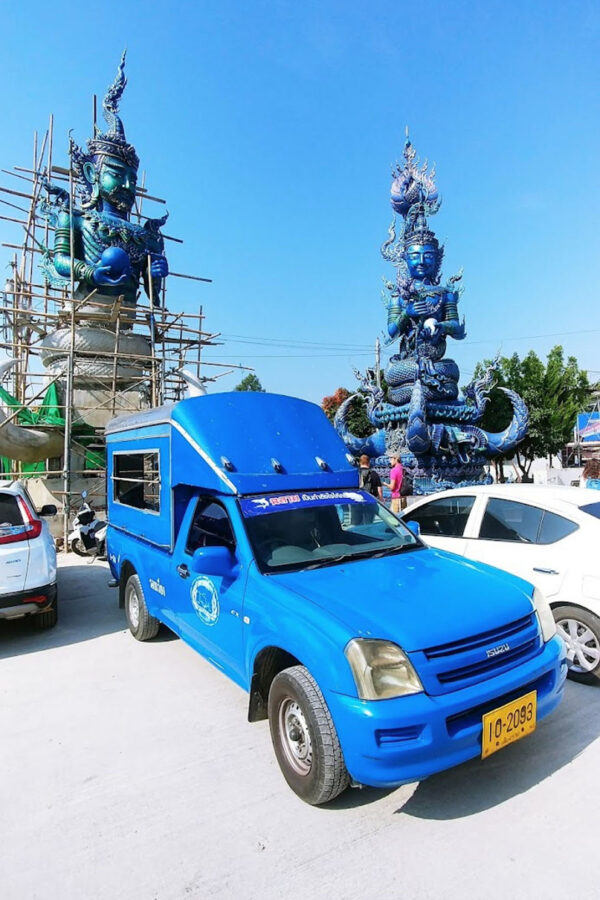
On the map: where to park near the temple
If you come with your own vehicle, free parking is available on the right of the temple. Be careful, I am not talking about the parking lot directly visible on the other side of the road, often crowded with minivans and tourist buses. This one is more discreet: you have to take the first road on the right, just before arriving at the main entrance of the temple.
For your convenience, I have prepared a map showing the points of interest mentioned in this article, some recommendations for eating nearby, and of course, the exact location of the parking lot.
Did you like the article? share on Pinterest!
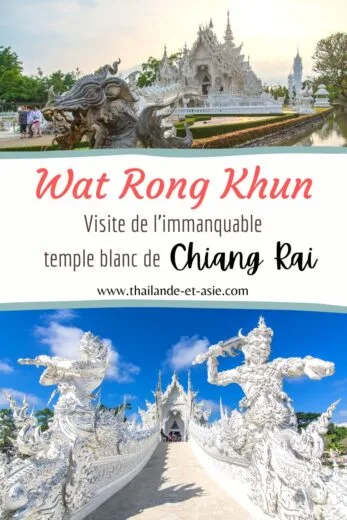


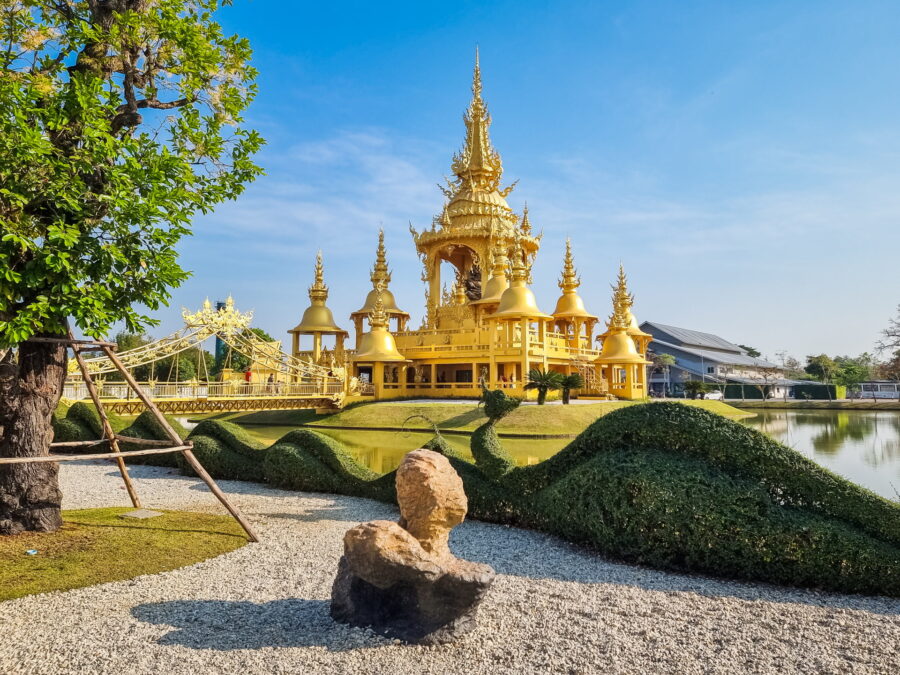
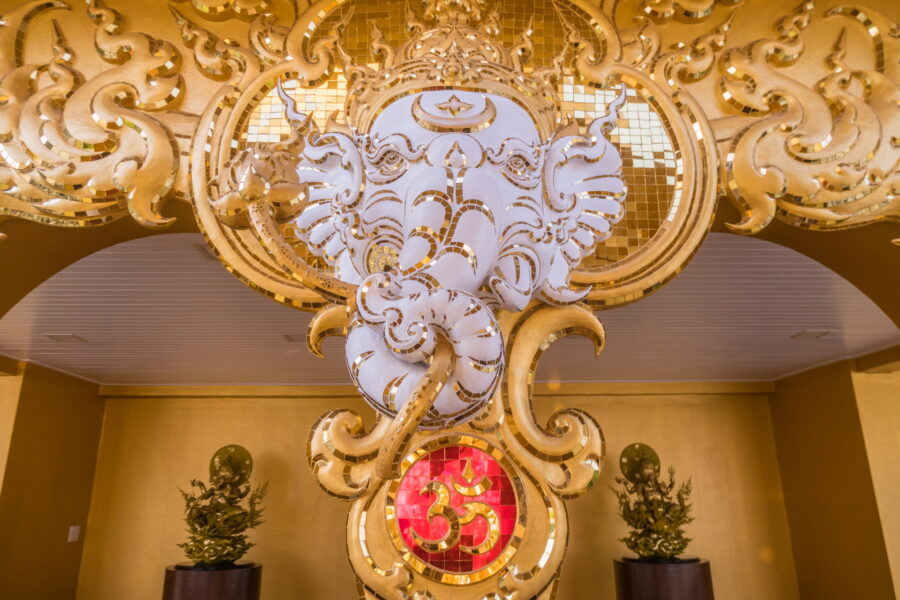
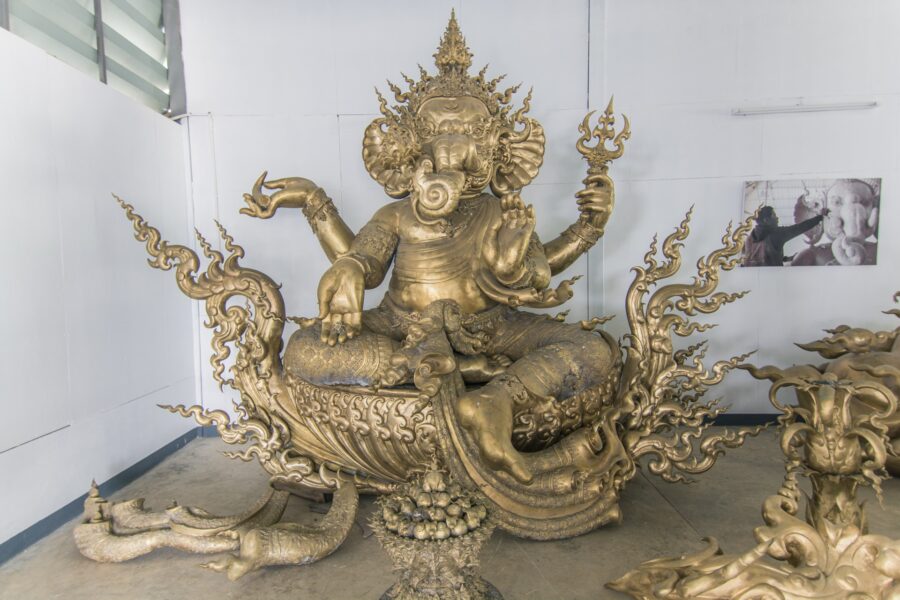



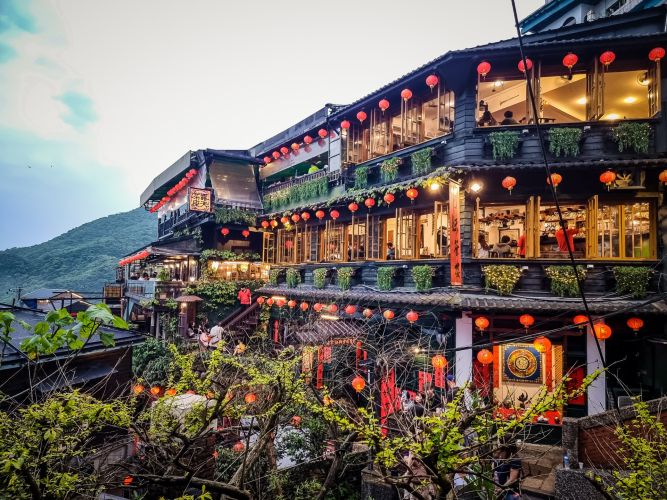
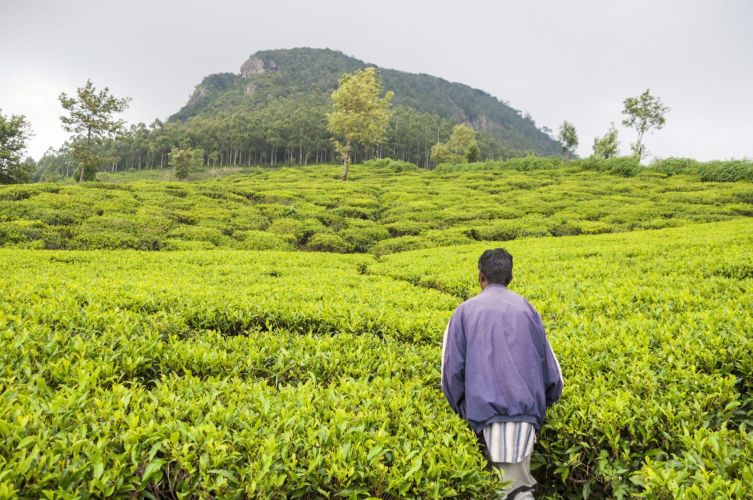

3 Comments
Hello Romain,
Thank you for your very interesting articles on Thailand. I haven't been back to the country since the military coup in 2014. It seems things have changed. I'm currently retired and planning to move to Thailand. I'm looking for all sorts of information, from the initial administrative procedures upon arrival and taxes to finding accommodation, etc. Do you maintain a blog on this topic?
Hello,
If you follow the news closely, unfortunately, I wouldn't say that the "wind has changed", it's not that simple... For the procedures, the first obvious one is the application and obtaining of the retirement visa (OA). The other step is to obtain health coverage, care is expensive, it is better to have good insurance here. For taxes, nothing changes, you will continue to pay your taxes in France (the source country of your income) and will not have any local taxes. For housing, you have sites like https://www.ddproperty.com/en which offer a lot of accommodation across the country.
Originally I thought I would have a section on expatriation, but because of my particular background and especially the fact that I preferred to focus on travel, I don't have more information on the subject (and even less a dedicated blog). There was once a well-designed blog but apparently it has disappeared... So, the blog and article that will help you the most at first is here
Hello Romain,
Great, and a big thank you for your quick reply. I'll check out your helpful links. Keep up the great work with your excellent articles. Best of luck!
Sincerely.